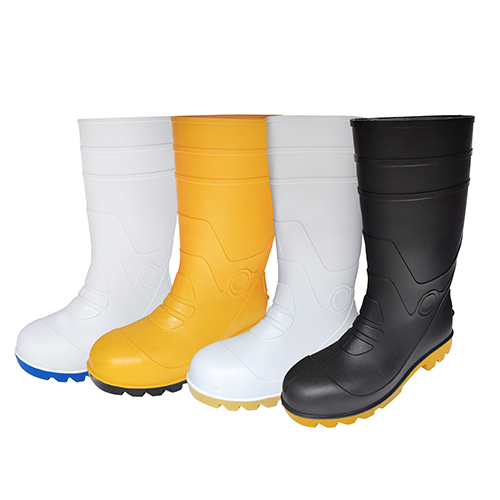The cleaning method of safety shoes varies depending on the material and style, but generally the following steps can be followed:

First, preliminary cleaning
Prepare tools: Prepare appropriate cleaning tools according to the material of the shoes, such as brushes, sponges, and wet cloths. For non-leather shoes (such as nylon material), it is recommended to use a sponge with warm water to clean, to avoid damage to the material.
Removal of floating dust: For frosted or dusty shoes, you should first gently brush with a soft brush or a special cleaning brush to remove floating soil and dust on the surface.
Second, deep cleaning
Detergent selection:
For leather safety shoes, if the shoes are stained with oil or difficult to remove stains, it is recommended to use a special leather cleaner to clean. These cleaners are usually effective at removing stains while protecting the leather from damage.
For non-leather shoes, such as nylon or mesh, you can use a mild detergent (such as soapy water) to clean.
Cleaning steps:
Apply the cleaner to the surface of the shoe and scrub gently with a brush or sponge, taking care not to exert too much force to avoid damaging the shoe.
For the lining part of the shoe, you can gently wipe with a damp cloth to remove sweat and stains.
Third, special material treatment
Abrasive leather shoes: After cleaning, the shoes should be allowed to dry naturally, and then gently brush the surface of the floating soil after drying. Be careful to avoid shoe wax or shoe polish, as they may impair the breathability of your shoes.
Suede safety shoes: If contaminated with dust, do not use a wet cloth to wipe or wash the shoes, but should use a special brush to wipe in a single direction in a circle, not to wipe back and forth. Use special spray when coloring, and spray special care agent after drying to restore color and extend service life.
Fourth, drying and maintenance
Natural drying: The safety shoes after cleaning should be placed in the indoor ventilated place to dry naturally, avoid direct sunlight or high temperature baking. Heat and humidity can cause damage to the material of shoes.
Waterproof treatment: In order to enhance the waterproof performance of safety shoes, it is recommended to apply water repellent after the shoes are dried. This helps prevent moisture from invading through the seam line and protects the internal structure of the shoe.
Lubricate metal parts: If there are metal parts on the safety shoes, lubricating oil should be applied regularly to prevent oxidation and rust, and reduce wear and extend service life.
Fifth, storage precautions
Clean and maintained safety shoes should be stored in a ventilated, cool, dry place, away from high temperature sources and chemicals. Proper storage helps to maintain the shape and performance of the shoes and avoid unnecessary damage.
In summary, the cleaning method of safety shoes needs to be adjusted appropriately according to the material and style, but in general, the steps of preliminary cleaning, deep cleaning, special material treatment, drying and maintenance, and correct storage should be followed.
Our factory was established in 2003 and we specialize in personal protective equipment, including PVC rain boots, rubber rain boots, EVA rain boots, safety shoes, helmets and other P P E products.
Contact: Lily
Phone: +8618622580676
E-mail: lily@dxyglobal.com
Whatsapp:8618622580676
Add: TIANJIN CHINA